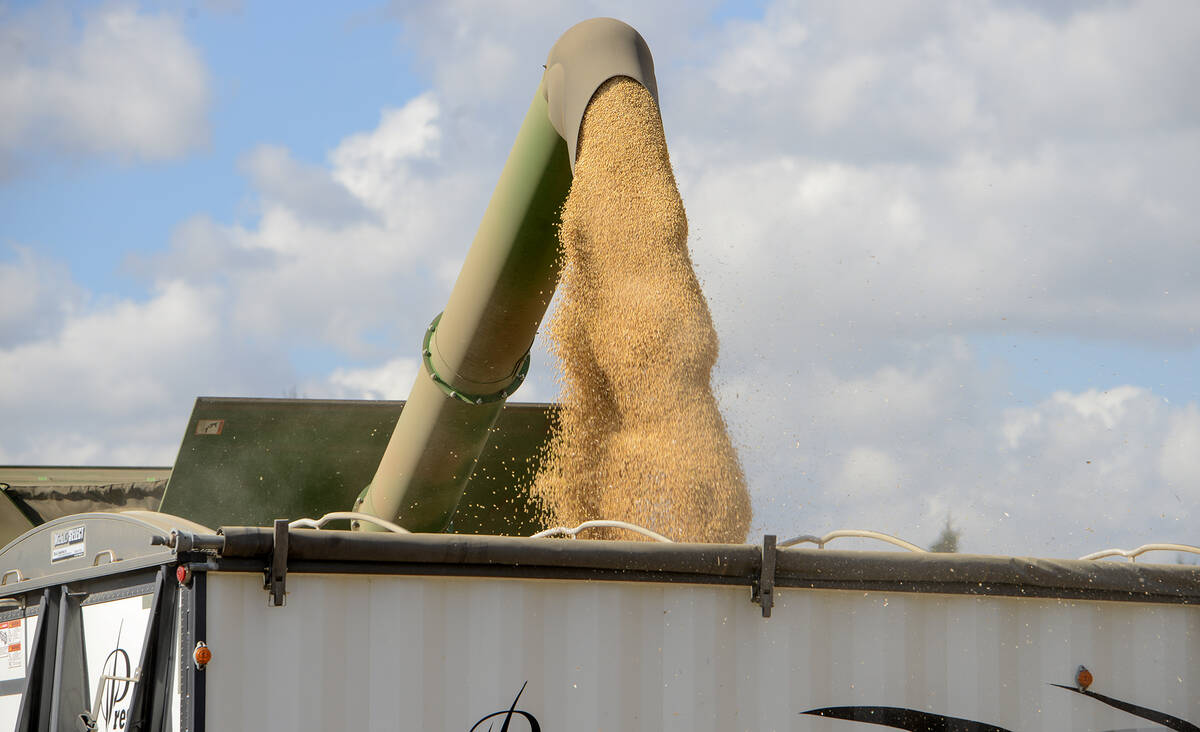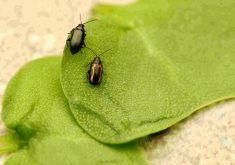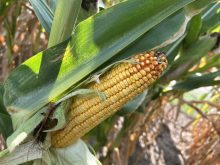Weekly provincial summary
Precipitation was variable across agro–Manitoba from May 29 to June 4 with values ranging from 0 to 57.1 mm. Isolated storms brought significant rainfall to areas in the Eastern region, parts of the Interlake, and parts of the Northwest. Teulon (57.1 mm) received the most precipitation in the past seven days.
Climate normals for total accumulated precipitation from May 1 to June 4 range from 42.5 to 73.0 mm., and are based on 30-year historical data. While much of the province received rain in the past week, most of the Central and Interlake regions had total precipitation amounts less than 50 per cent of normal. Pockets of the Interlake, Northwest and Southwest have had higher than normal precipitation.
Read Also

Grain markets hungry for U.S. data
The U.S. government shutdown meant that futures markets were left without robust grain supply information
Percent Normal Accumulated Growing Degree Days (May 1 – June 4), represents the variation of accumulated Growing Degree Days (GDD) from the historical record over a 30-year period. All of the agricultural regions in the province have accumulated more than 120 per cent of normal GDD.
Provincial seeding progress is at about 97 per cent completion, slightly ahead of the 5-year average of 96 per cent for Week 23. (see Figure 1 at top).
To find interactive soil temperature/moisture and air temperature information see Agri-Maps Current Weather viewer.
Overview
Good emergence is being reported on spring cereals and field peas. Cereals are moving along rapidly with fall rye fields fully headed out. Crops have shown rapid development and remain in good condition except for some later seeded fields demonstrating uneven emergence due to topsoil dryness. Soybean planting near completion with just a few isolated fields left to be seeded. Canola ranged from germinating/emerging to the late two leaf stage for the earliest seeded crop. Growers continued to monitor fields for flea beetles and remained concerned that the hot, dry weather would make canola seedlings less able to withstand insect damage.
Cereals
Corn growth stage ranged from the one to the five leaf stage for some of the earliest seeded fields. Crop remained in good to excellent condition and demonstrated rapid growth in the warm weather.
Spring cereals ranged from the one leaf to four leaf stage with herbicide application underway.
Fall rye is at full head emergence. Winter wheat crop ranged from the late boot to heads starting to
emerge. Winter cereals remained in good to excellent condition.
Oilseeds
Canola planting has made significant progress during the last week with approximately 97 per cent of the projected acres being planted across the province.
Still some reports producers with canola seed sitting in dry soil; rainfall would be welcomed.
Sunflower growth stages range from V1 to V2 stage for the earliest seeded fields.
Most flax crops are at growth stage 4 to very early stage 5 and the crop is expected to advance rapidly
given the growing conditions.
Pulses and Soybeans
Field pea planting is at 100 per cent complete across the province.
Good emergence has been noted on most pea fields around the province with the most advanced fields in the 4th to 6th node stage.
Soybean planting has progressed with 99 per cent complete.
Dry bean planting is now complete with the exception of a few isolated fields. Beans are emerging but
have struggled in areas where soil moisture was lacking and producers had to plant deeper than normal.
Forages & Livestock
Forages
First cut alfalfa has begun for several dairy operations in the Steinbach and other regions and most beef cattle have been moved to pasture. It is estimated that hay yields will be approximately 70 to 80 per cent of normal of first cut.
Alfalfa is flowering and the first cut has started for dairy quality, and grasses are heading out.
Pasture conditions are fair but a rainfall is needed as current heat conditions will be hard on regrowth.
Corn intended for silage is growing well with the warm weather.
Some areas received well needed rain that will boost pasture and hay growth.
Livestock
The hot weather has been hard on livestock and several producers have reported animals exhibiting symptoms related to heat stress.
Most cattle have now been turned out to pasture. With cattle numbers at auction declining, some yards are nearing their last sale of the spring.
Reports of high black fly populations in some pastures.
Water in dugouts is adequate, though ground water levels appear to be dropping. Dugouts are 80-90 per cent full.
Regional Comments
Southwest
Temperatures have been variable and have been trending upwards. Daytime temperatures reached the mid-30s. Most weather stations in the region received 2-3 mm, but in the northern side of the region, Russell and Forrest received 45-56 mm, and in southern areas, Virden and Waskada received 33-35 mm of rain. The majority of the areas like Rivers, Miniota, Shoal Lake, Souris, Minnedosa, Wawanesa, and Killarney reported below normal rainfall during this spring.
General seeding has been wrapping up with sunflower seeding at 95 per cent complete and some early seeded crops at first true leaves. Soybean seeding is 98 per cent complete, with early soybean and dry bean emerging but not trifoliate yet.
Cereals are at the one to five leaf stage and herbicide application has started.
Peas are at the four to six node stage. Herbicide application wrapping up this week.
Canola is estimated at 95 per cent complete with early stages of germination. Some fields need moisture to get good emergence as canola was seeded in dry conditions. Some areas reporting flea beetle activity.
Grain corn is 95 per cent done and silage corn is 80 per cent complete. Some early-seeded corn is at the V2 to V3 stage.
Fall rye and winter wheat are progressing well, but height is short due to dry weather conditions in some fields. A good rain can help their yield potential at this stage.
With the warm conditions weeds have been emerging and growing as fast as the crop. Many producers are wanting to spray, however the hot days and wind are limiting the ability to get spraying done. Spraying will be general this week.
Northwest
A week of showers/thunderstorms, high temperatures and high relative humidity contributed to a mixed week. While the high temperatures and soil moisture encouraged rapid crop growth, some extreme precipitation events (localized) caused some damage in areas. Storms early in the week brought large amounts of rain in a short period of time to Gilbert Plains and Ashville area.The weekend saw a couple more events bring large amounts of precipitation with two storms moving through an area just south of Swan River. Overland flooding, high water levels and road washouts occurred in these areas. Some fields were cut from waterflow.
Spring wheat across the region sits at approximately 98 per cent complete. Majority of spring crop has emerged and looks uniform. In-crop herbicide application has begun where appropriate stages have been reached.
Pea seeding is complete and emergence looks good and is uniform. Current staging is at the third to fourth node stage.
Soybean seeding is complete across the region. Recent rainfall and high temperatures have moved crops along with most fields at the unifoliate growth stage.
Canola seeding is approximately 90 per cent complete. Earliest seeded canola is approx. two leaf stage, while remainder of the canola crop continues behind. Earlier seeded fields are starting to see some flea beetle pressure and some requiring control.
Winter wheat and fall rye are looking good and advancing with the exception in the Swan Valley, where areas that received heavy rains have flattened parts of the field.
Central
The past week has been hot and windy. Under these conditions, the soil has been quickly drying and many producers require moisture to enhance the germination of later seeded crop, to assist with winter cereals as they enter the reproductive stage, and to maintain the growth of forages and hay in pasture.
Patchy thunderstorms have supplied ample water to many producers in the region over the past week, but others, sometimes only a few miles away, have been left dry. The region would greatly benefit from a widespread rain.
Seeding is complete except some wetter ground or land being put to greenfeed or silage. Overall emergence on crops has been good providing there was moisture at seeding depth. The earliest seeded crops have had the most successful and uniform emergence, due to the dryer soils at later planting. Most cereals are around the three to six leaf stage, canola around the three leaf stage, and soybeans from emerging to unifoliate, and some with the first trifoliate emerging.
Corn growth stage ranges from V1 to V4, with some plants visibly showing moisture stress and associated nutrient deficiency symptoms, especially phosphorus purpling.
Dry bean planting is at 99 per cent complete and earlier planted fields are starting to emerge. A few reports of slow emergence, if seed was planted deeper than normal.
After some delays due to high winds, spraying of weeds is now in full swing. Spraying is often taking place in the early morning to avoid the heat. A small number of producers have also sprayed for flea beetles in canola, and cutworms have been noted in some soybean fields.
Eastern
Very hot and humid across the Eastern Region with thunderstorms and the potential for violent weather a concern most afternoons and evenings. Rainfall accumulations ranged from 3 mm to over 76 mm with very wide variations across the region. Areas that received lower rainfall amounts were experiencing uneven crop emergence and seed stranded in dry topsoil, particularly in the case of canola. Cropland soil moisture rated as mostly good across the region but it was noted some cropland had slipped into the short soil moisture category.
Strong southerly winds worked to limit spraying progress and also contributed to drying out topsoil and stranding shallow seeded crop, particularly canola. High daytime temperatures also affected spraying progress depending on the crop and chemistry involved.
Across the Eastern region, seeding was completed and producers attention turned to spraying as crops and weeds advanced quickly where emergence was good. About 15 per cent of acres across the region had received a first pass of herbicide over the reporting period.
Spring cereals ranged from the one leaf to four leaf stage and in some districts up to 25 per cent of acres had received their first pass of herbicide. A few late seeded fields are still emerging.
Corn growth stage ranged from the V1 to V5. In some districts, first pass herbicide applications are close to complete. The crop remained in good to excellent condition and demonstrated rapid growth in the warm weather.
Sunflower growth ranged from the V1 to V2 stage with the crop demonstrating rapid growth and rated as being in good to excellent condition. Very limited reports of cutworm damage but growers continued to monitor their fields. In some districts, first pass herbicide applications were up to 50 per cent complete but there was a lot of variation between growers given the wide window of planting dates.
Canola ranged from germinating/emerging to the late two leaf stage for the earliest seeded crop. Growers continued to monitor fields for flea beetles and remained concerned that the hot, dry weather would make canola seedlings less able to withstand insect damage. There were limited reports of field perimeters receiving an insecticide application.
Soybean growth stage ranged from cotyledon to the second trifoliate leaf for the earliest seeded crop. Crop growth and development was rapid in the warm weather. In later seeded fields producers remained concerned about topsoil moisture availability at seeding depth, particularly in those areas with lower overall rainfall accumulations.
Interlake
Soil moisture varies from very dry to adequate depending on the area. Dry conditions continued throughout the week, with scattered showers over the weekend. Rainfall varied across the region.
Soil moisture is good in Fisher Branch area due to the recent rainfall that was received on Monday. The North Interlake region received some rain however the east side of the region missed the rains. Some parts of the South Interlake received about 25 mm of rain over the weekend. Frequent rains will be needed to sustain crop growth through the season.
Seeding progress has been excellent in the Interlake region, with most of the region reporting 95 to 99 per cent complete except for later annual forages. Seeding is wrapping up this week for soybeans and corn in wetter areas.
Dry areas have seen uneven emergence of canola due to lack of adequate moisture. Cereals such as wheat, oat and barley have good even stands. Most soybeans are at the cotyledon to unifoliate stage, cereals are at one to three leave stage, and corn is at V2-V3 stage.
Flea beetle pressure on canola varies in the region. Flea beetles continue to be a concern in canola fields, and are being closely monitored, especially with the high temperatures being forecast. However, there is no real amount of flea beetle pressure in the Arborg area, but producers will continue to monitor. No evidence of cut worms and grasshoppers yet in the Arborg area but some small grasshoppers doing minor feeding on soybeans occurred in Warren area. Insecticide application has started in a few fields, particularly with multiple stresses.
Recent hot temperatures are concern for spraying when crops are under stress. The hot weather has hampered spraying and producers are restricted to spraying early mornings or late evenings. Weed pressure is high in rainy areas in the North Interlake area, whereas the South Interlake area reported lighter than normal weed pressure.
Spraying in wheat and soybean fields has started. Common weeds of concerns include kochia, green foxtail, wild oat, and lamb’s quarters.















